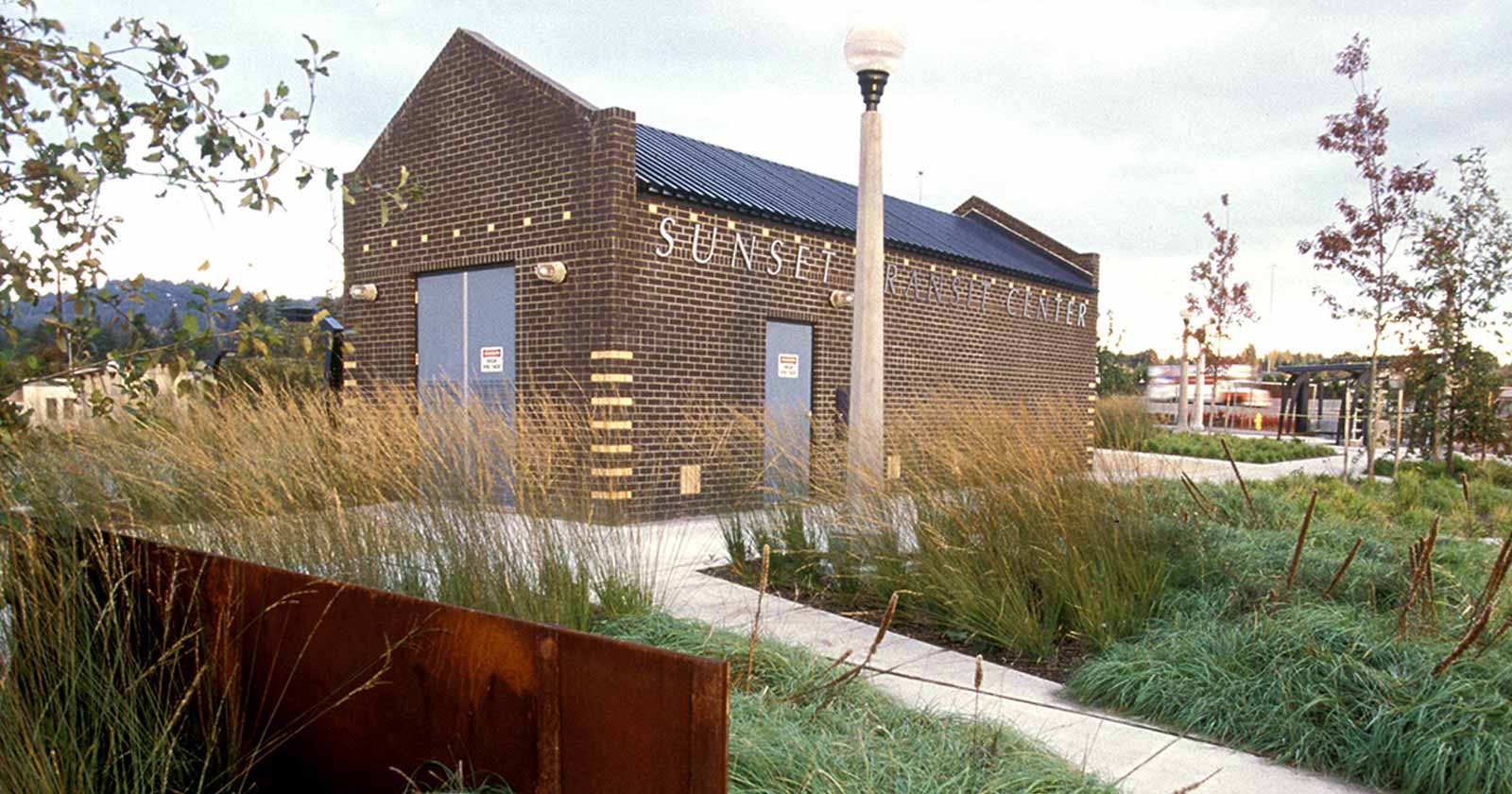
Public Art on MAX Blue Line — Westside
The Westside MAX Public Art Program was one of the country’s earliest, most ambitious efforts to integrate the vision of artists into public transit and the first such program for TriMet. Over 20 artists contributed significantly to the design of the largest public works project in Oregon history. Collaborating with architects and engineers, they created over 100 permanent art elements, bringing individual identity to each of the 20 stations and honoring the history, culture and landscape along the line.
Hatfield Government Center Station
Christine Bourdette, 1998
Christine Bourdette’s theme “Gathering and Dispersal” acknowledges the agricultural roots of Washington County.
- A sculpted bronze rail at the station building features local plants and products
- Etched drawings on the shelter glass evolve from a tangle of vines to a basket weave pattern
- Granite balls appear to roll out of bronze baskets in a planting strip between the trackway
- Miles Pepper’s scarecrow weather vane fends off crows from the top of the station building and turns a seedpod in the lobby below
 Platform
Platform
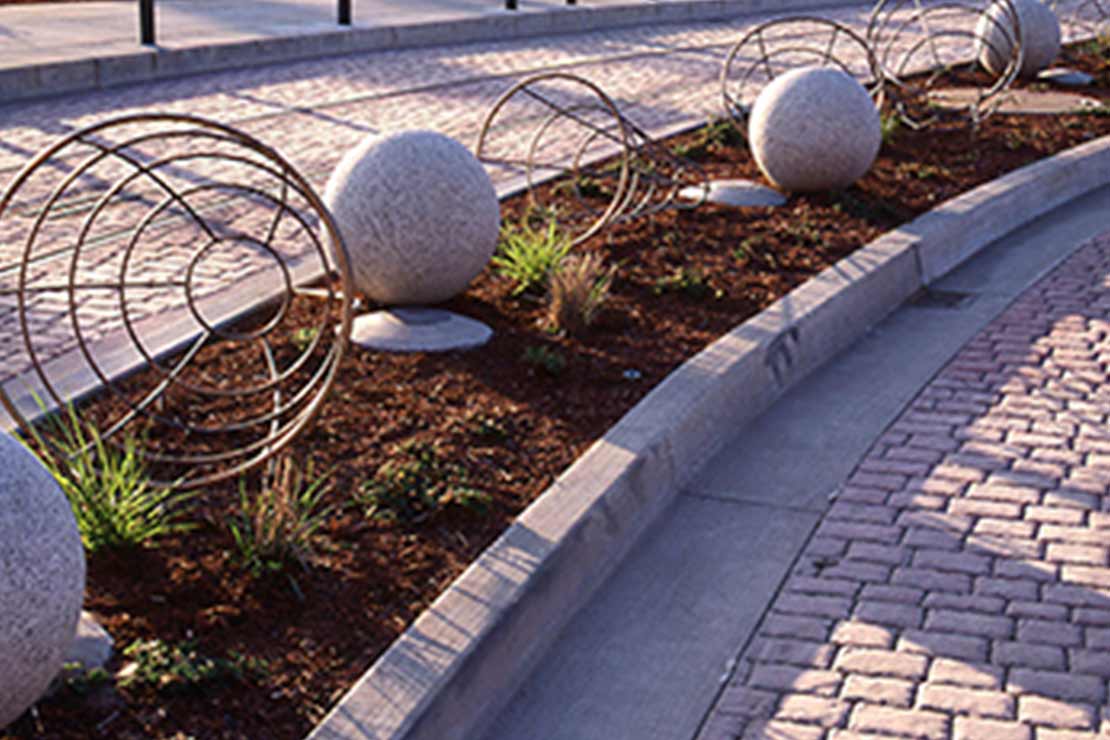 Planting strip
Planting strip
Hillsboro Central/SE 3rd Ave Station
Hillsboro design team, 1998
Hillsboro design team artists honor everyday life in a people’s history of Washington County.
- Photographs and bronze objects set in the walls of the station building celebrate local heritage
- Excerpts from historic and contemporary writings are sandblasted in the surrounding pavement
- A plank road is replicated in the vestibule
- A letter from the 1870s is etched on the station shelter glass
- Keith Jellum’s weather vane recalls bygone train signals
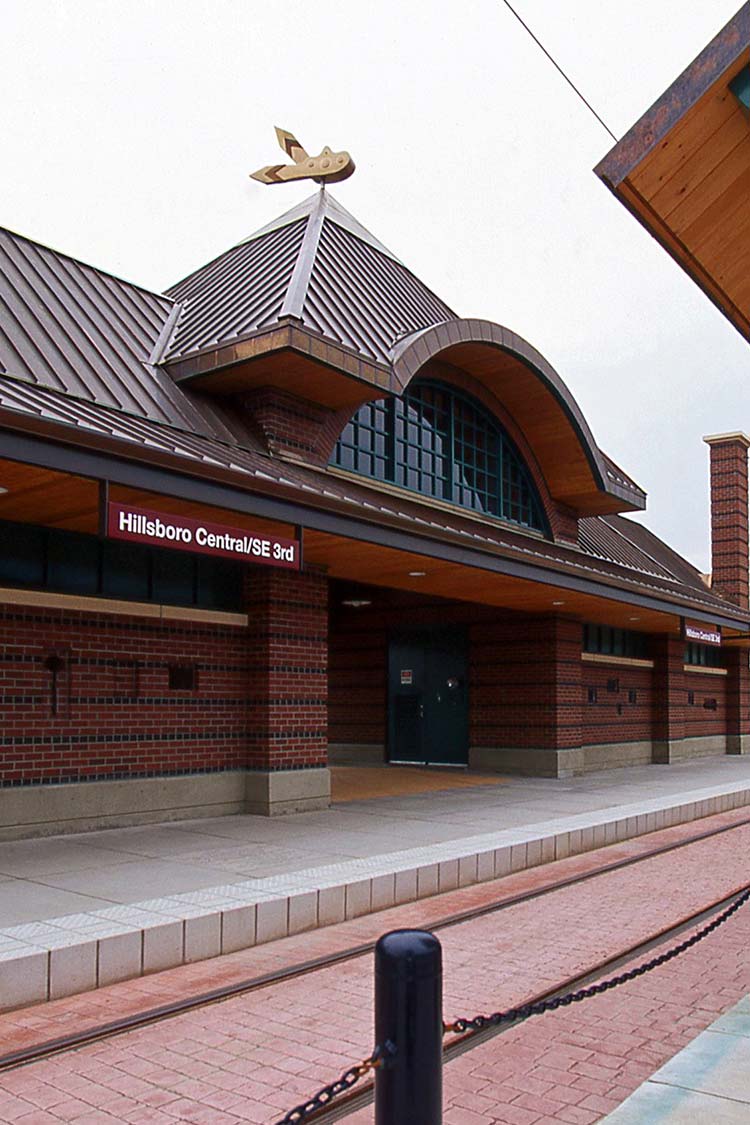 Hillsboro Central building
Hillsboro Central building
Tuality Hospital/SE 8th Ave Station
Hillsboro design team, 1998
Hillsboro design team artists used the theme of light, hope and healing to connect the station with the nearby hospital.
- 300 bronze swallows in the sidewalk and platform paving accompany a Shakespeare quote
- Jane Kies created the illustrations for the Quilt of Traditional Remedies
- Swallow weather vanes by Miles Pepper top the shelters
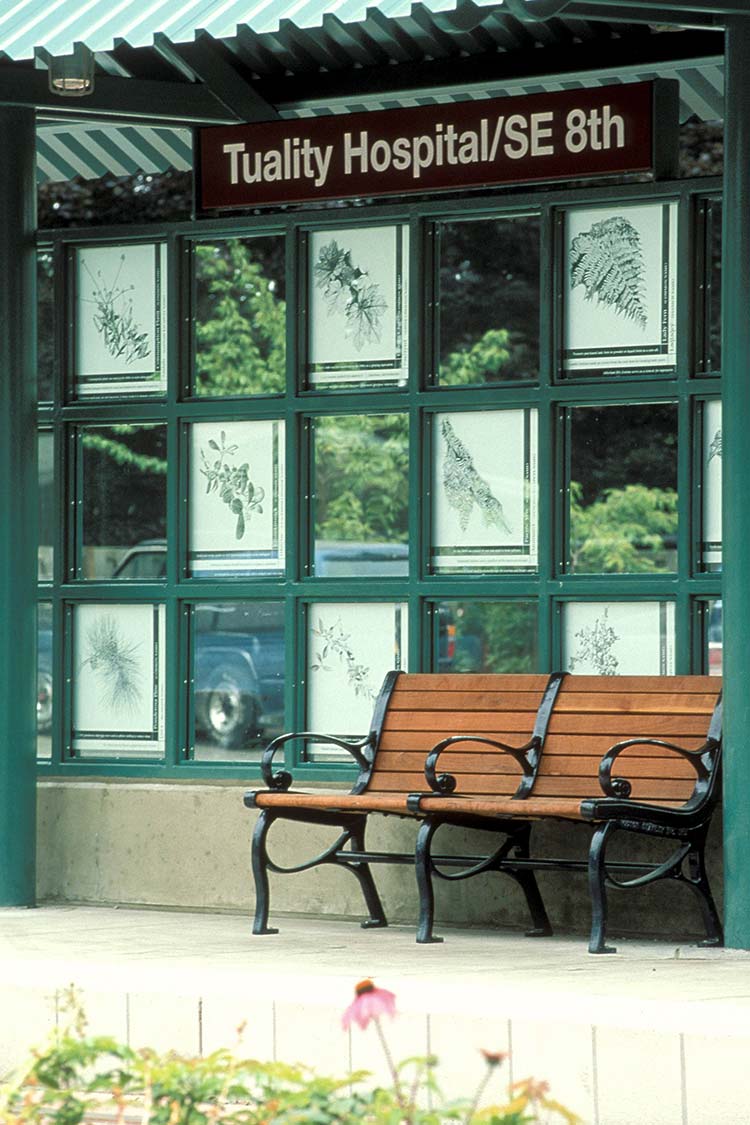 Quilt of Traditional Remedies
Quilt of Traditional Remedies
Washington/SE 12th Ave Station
Linda Haworth, 1998
Linda Haworth developed the theme “Sweet Home and the Garden of Life” for this residential station area.
- Neighbors created over 650 tiles for a 140’ wall along the platform and a bench
- A mosaic of birds in flight covers the top of the bench
- Planters are shaped like traditional cheese making kettles
- A colored path looks like carpet
- Nate Slusarenko’s weather vane on the systems building resembles a souvenir snow dome
 Tile wall and planters
Tile wall and planters
Fair Complex/Hillsboro Airport Station
Hillsboro design team, 1998
Hillsboro design team artists celebrated the spirit of competition and displays of skill near the site of the annual Washington County Fair and the Hillsboro Air Show.
- An ivy-covered trophy boasts “The World’s Greatest”
- “Tree rooms” provide shady resting places along the path through the parking area
- Historic model airplanes by Glen Geller and Curt Oliver spin over an aerial view landscape to the northwest of the station
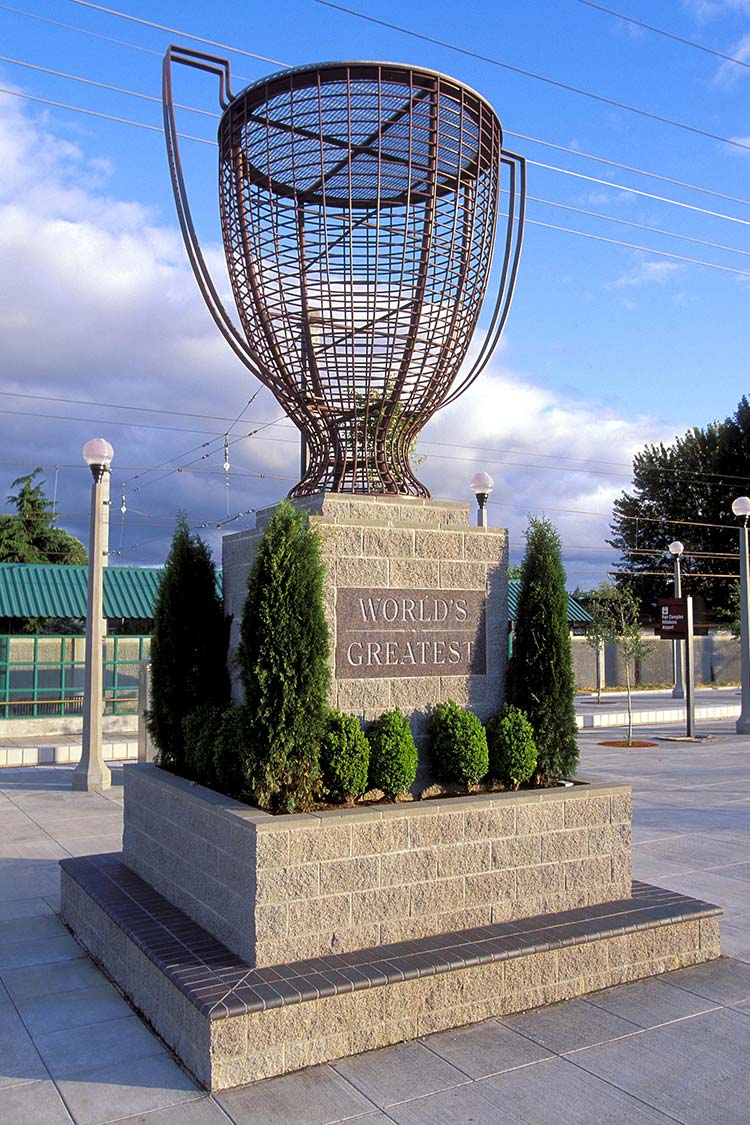 Trophy
Trophy
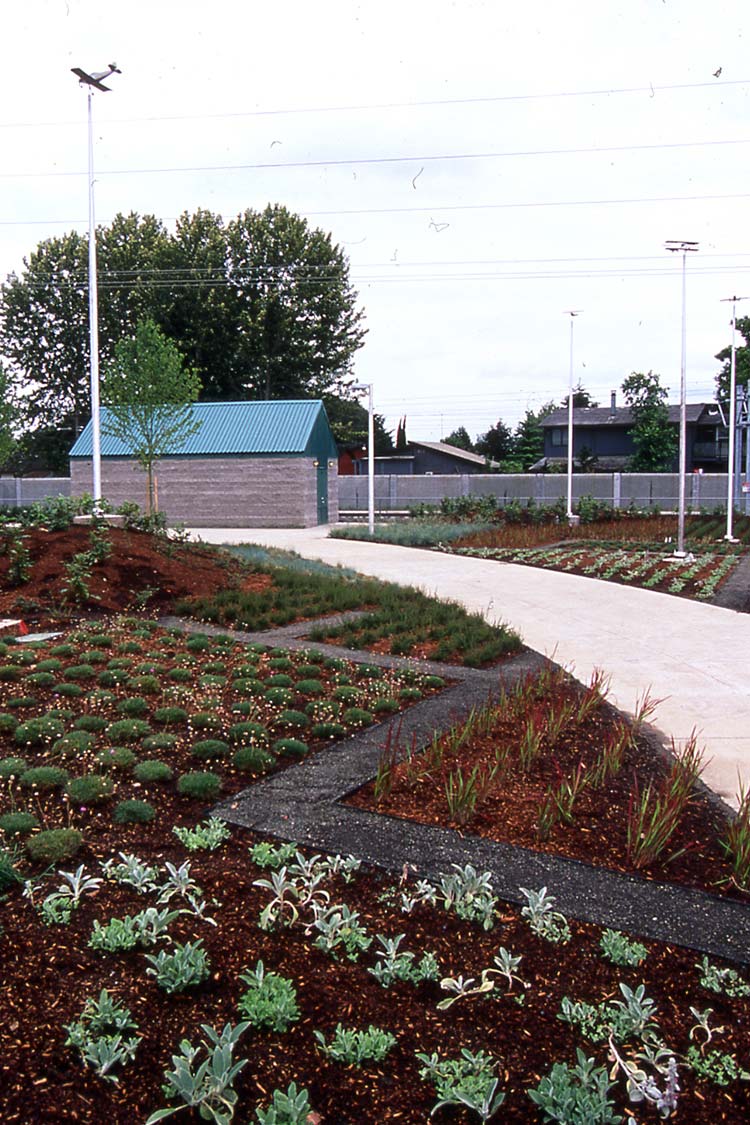 Landscape
Landscape
Hawthorn Farm Station Station
Patrick Zentz, 1998
Patrick Zentz was inspired by the nearby wetlands and adjacent high tech industries to translate the local topography into sound.
- Tone bars encased in the windscreen shelter chime as the train approaches
- Sounds from a nearby wetlands are projected at the platform
 Windscreen shelter
Windscreen shelter
Orenco/NW 231st Ave Station
Hillsboro design team, 1998
Hillsboro design team artists celebrated trees and the history of Orenco, once the company town for the Northwest’s largest nursery, Oregon Nursery Company.
- Branch benches are by Nancy Merritt
- An illustration of the nursery’s grafting technique is set into the sidewalk on the south side of the station
- Granite rings across from the platform contain text by poet Kim Stafford
- A path leads to an old oak grove, preserved for the station
- Stuart Keeler and Michael Machnic’s hand-forged tree sits on top of the systems building
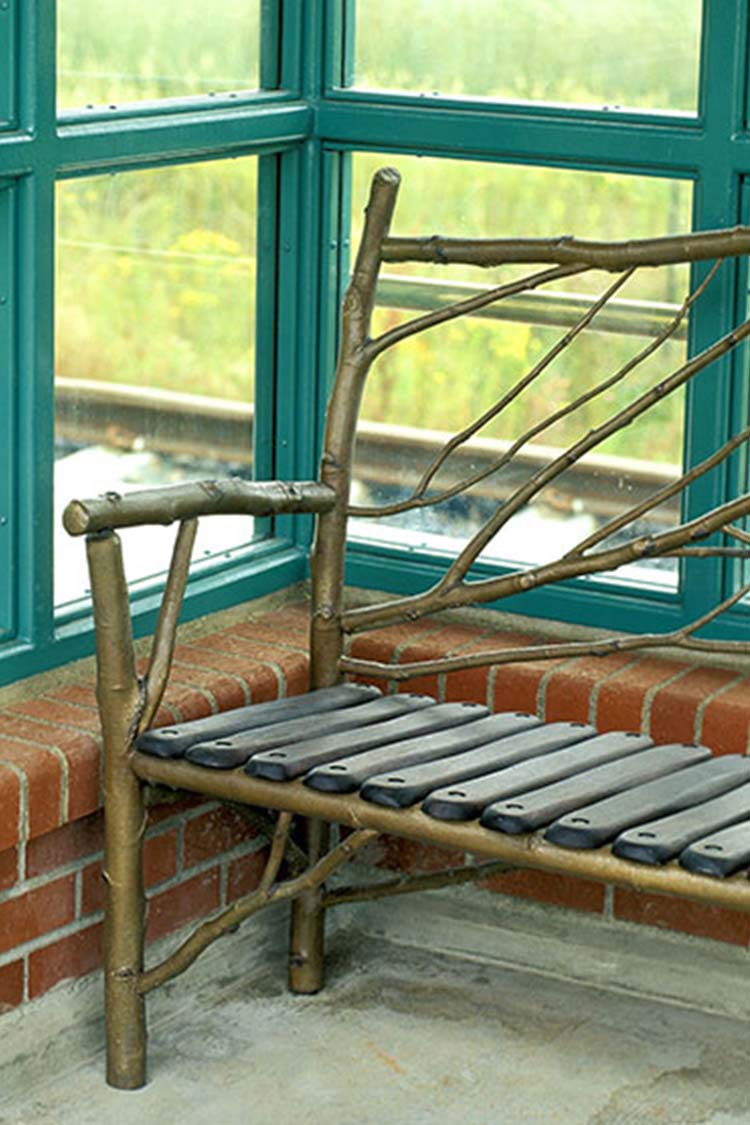 Bench
Bench
Quatama/NW 205th Ave Station
Hillsboro design team, 1998
Inspired by the rapidly changing landscape and nearby scientific research institutions, Hillsboro design team artists created a place where art, science and nature intersect.
- A river-like path includes boulders with scientific images and a basin showing the mechanics of rainwater run-off
- Animal tracks cross the platform
- A map of the Tualatin River watershed appears on the shelter glass
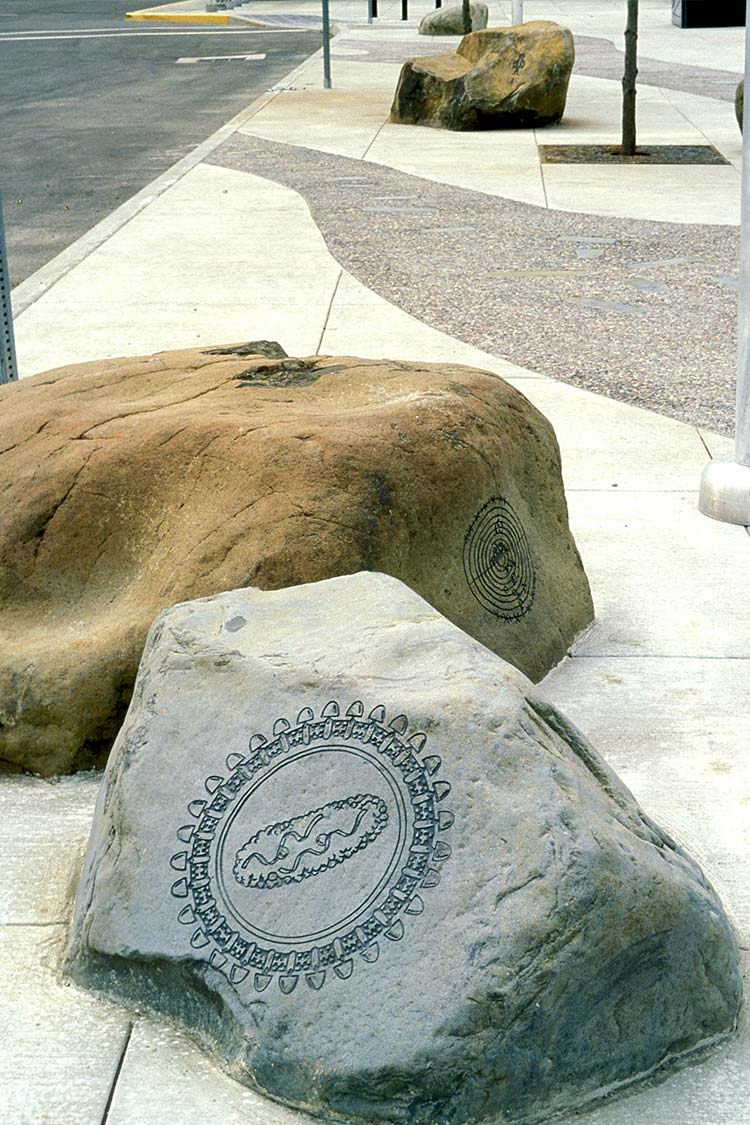 Path and boulders
Path and boulders
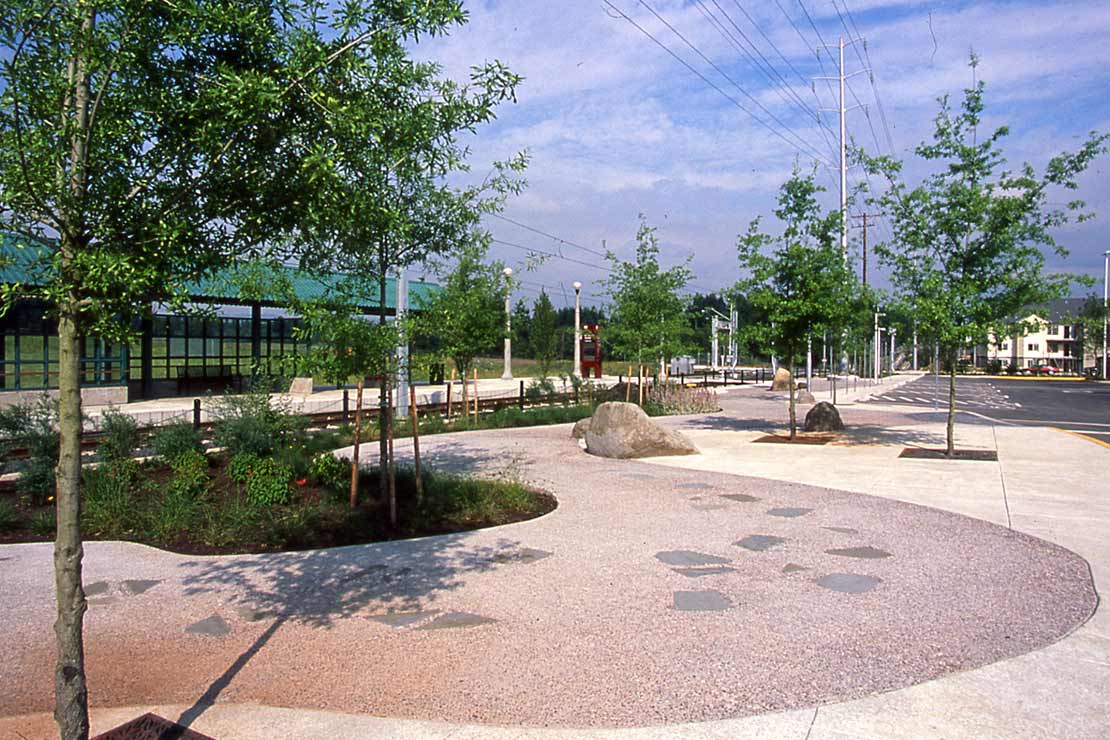 Landscape
Landscape
Willow Creek/SW 185th Ave Transit Center
Westside design team, 1998
Westside design team artists imagined passengers reading under the cherry trees near where a library branch had been planned and now there is a community college.
- “Living room” furniture is sandblasted with literary names
- Authors and characters are hidden in tile word letter puzzles
- Letters from the world’s alphabets are scattered in the concrete
- Christopher Rauschenberg’s Time Window documents the view from the shelter in 1994
- Brick patterns on the systems buildings recall falling cherry blossoms
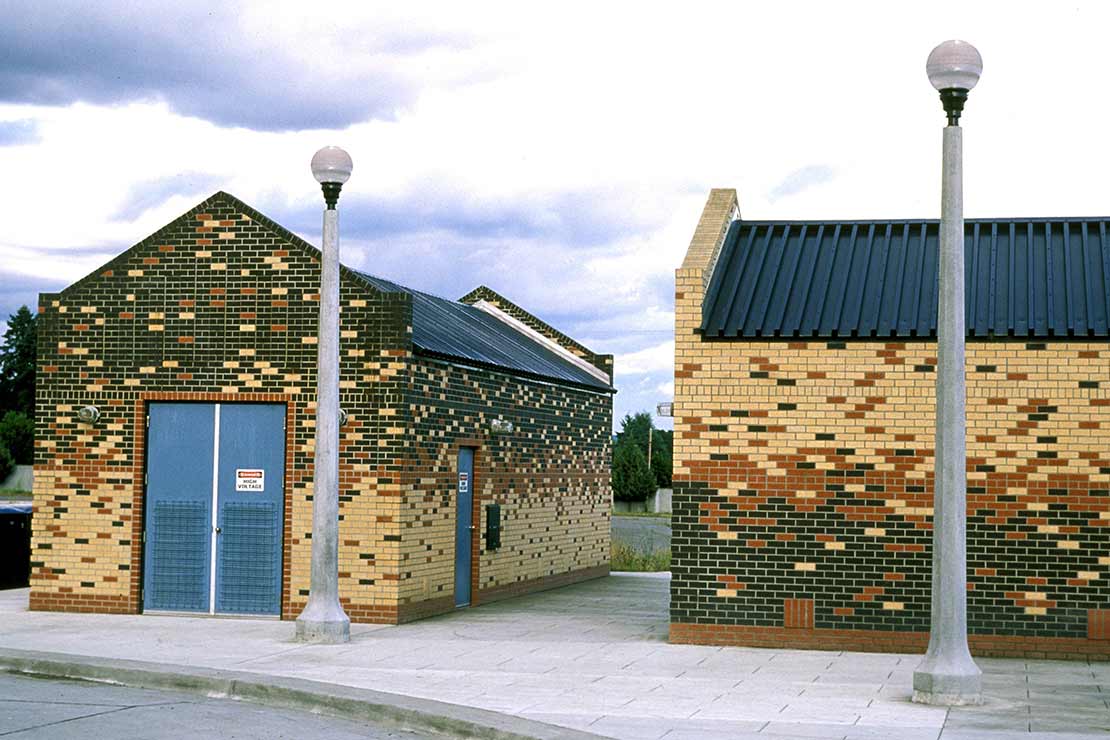 Systems buildings
Systems buildings
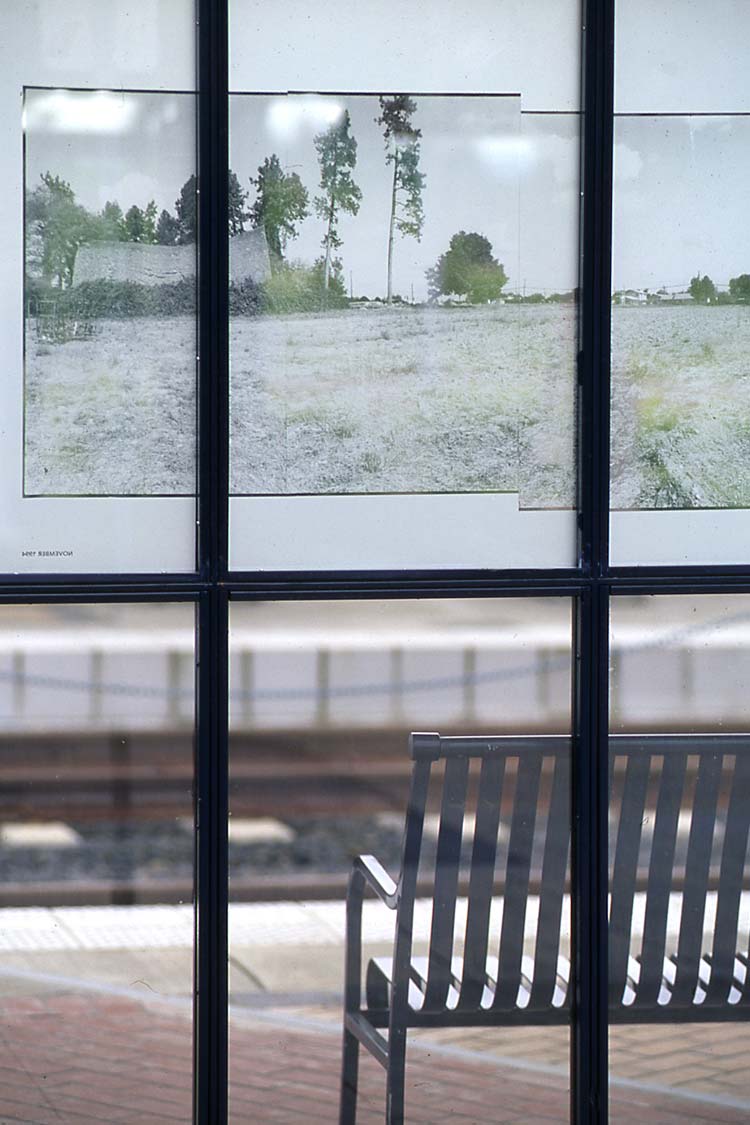 Time window
Time window
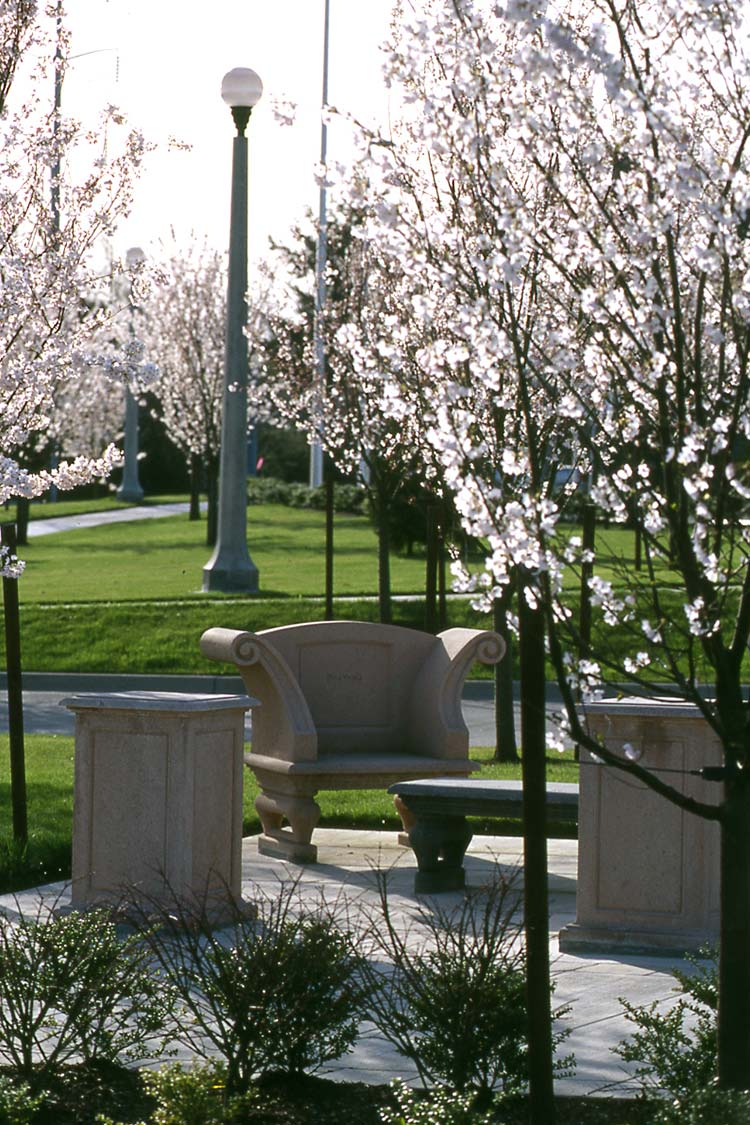 Living room
Living room
Elmonica/SW 170th Ave Station
Westside design team, 1998
Westside design team artists and Don Merkt echoed the act of transplantation—moving objects, plants and people from their original environment to a new place.
- Three brick carts symbolize transplanting, transporting, transforming
- Words with the prefix “trans” are arranged in a circle in the plaza paving
- Brick and rail “rugs” inside the shelters suggest trackway gone awry
- Christopher Rauschenberg’s Time Window documents the view from the shelter in 1994 Paul Sutinen designed the Elmonica gate and the path to the maintenance facility
- On the path, “welcome mats” in eleven languages greet visitors
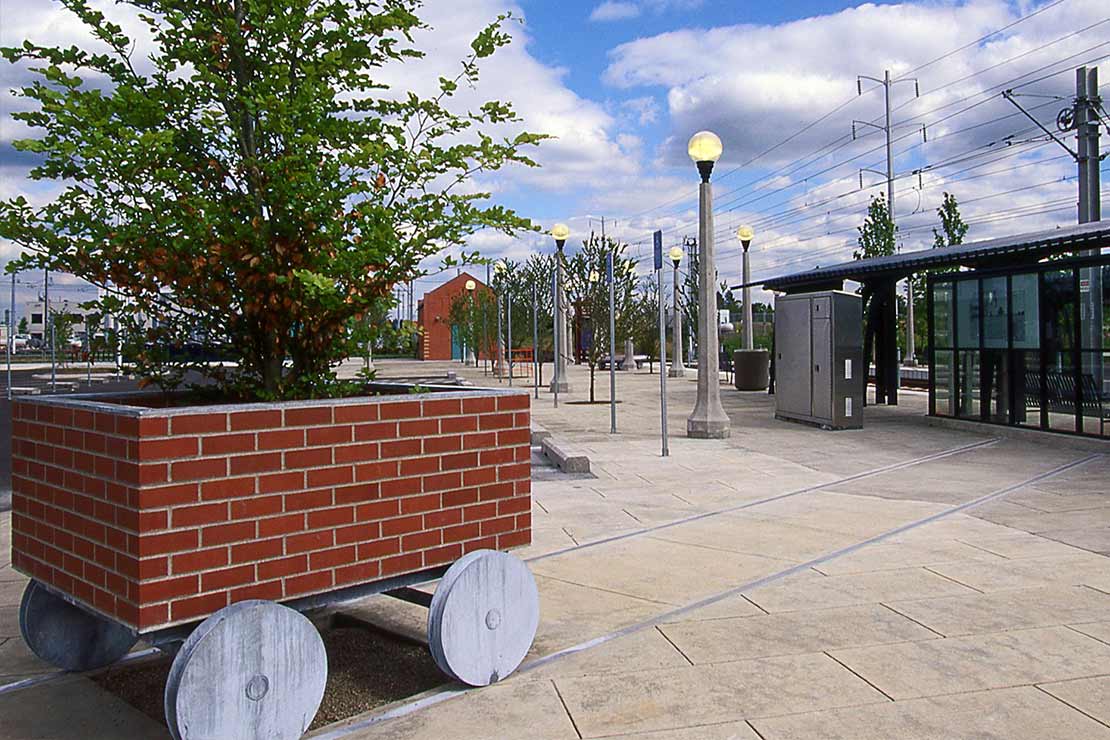 Brick cart
Brick cart
Merlo Road/SW 158th Ave Station
Fernanda D’Agostino, 1998
Fernanda D’Agostino designed imagery and an accessible trail to connect the station with the Tualatin Hills Nature Park.
- Glass windscreen images contrast the natural and man-made
- An aerial photograph of the site taken in 1994 and a map showing bird migrations are etched on the glass
- Flagstone “rugs” complement seating inside the shelter
- The Merlo Path features trail markers, perching poles and boulders with images from the natural world
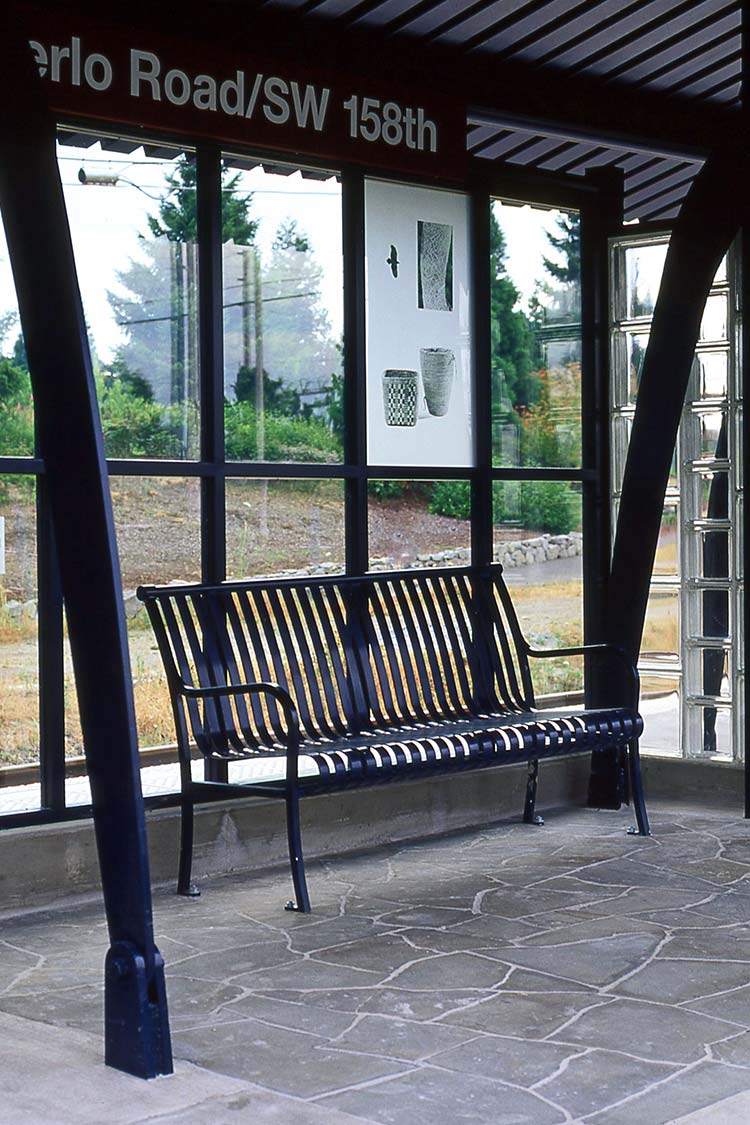 Shelter
Shelter
Beaverton Creek Station
Westside design team, 1998
Westside design team artists and Anne Connell designed the “navigation station” for this location between a new apartment community and a 74-acre woods.
- Passengers mark time and contemplate the universe with a 24-hour clock and a map of the solar system on the systems building
- Two compass roses embedded in the platform indicate true north
- "Eastbound” and “westbound” are etched in 11 languages on bronze plaques along the trackway
- Brick patterns in the platform suggest borders on old maps
- Christopher Rauschenberg’s Time Window documents the view from the shelter in 1994
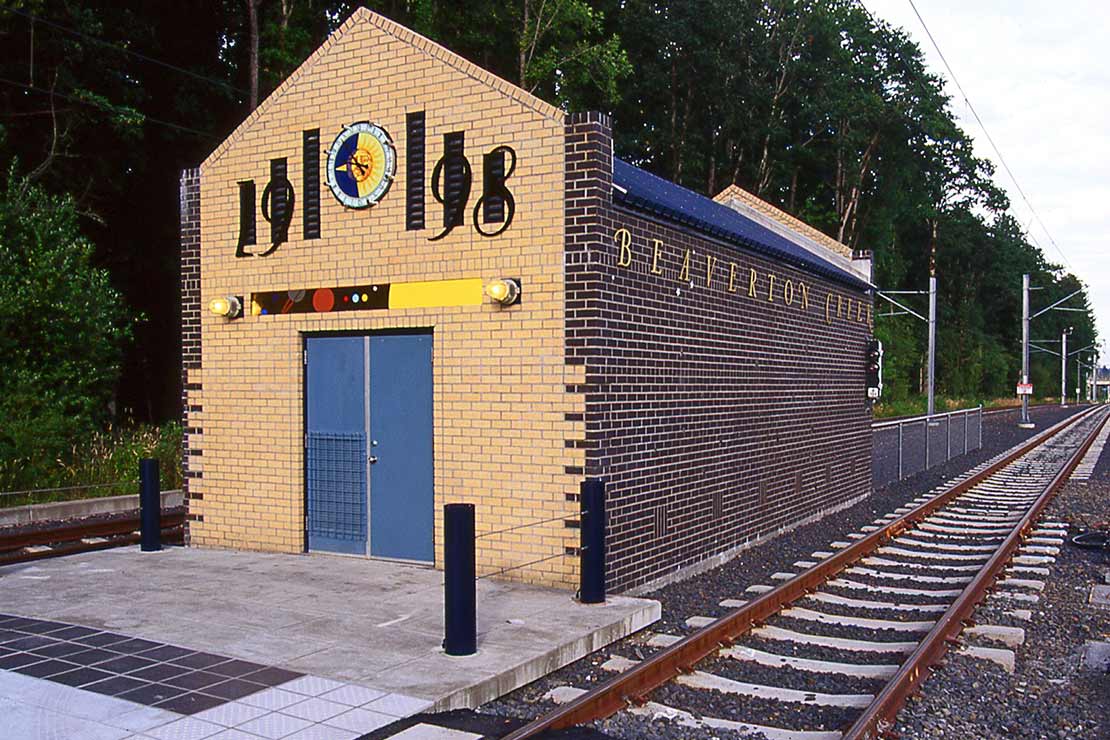 Systems building
Systems building
Millikan Way Station
Westside design team, 1998
Trees, wetlands and the nearby Tektronix campus inspired the Westside design team artists’ theme of nature bumping up against high technology.
- Brick patterns on the systems buildings suggest coniferous and deciduous trees
- The songs of local birds are etched in bronze plaques along the trackway
- Clusters of leaves, seeds and pine cones are sandblasted in 30 locations in the plaza
- Test patterns and mathematical symbols on graph paper are created in terrazzo
- Christopher Rauschenberg’s Time Window documents the view from the shelter in 1994
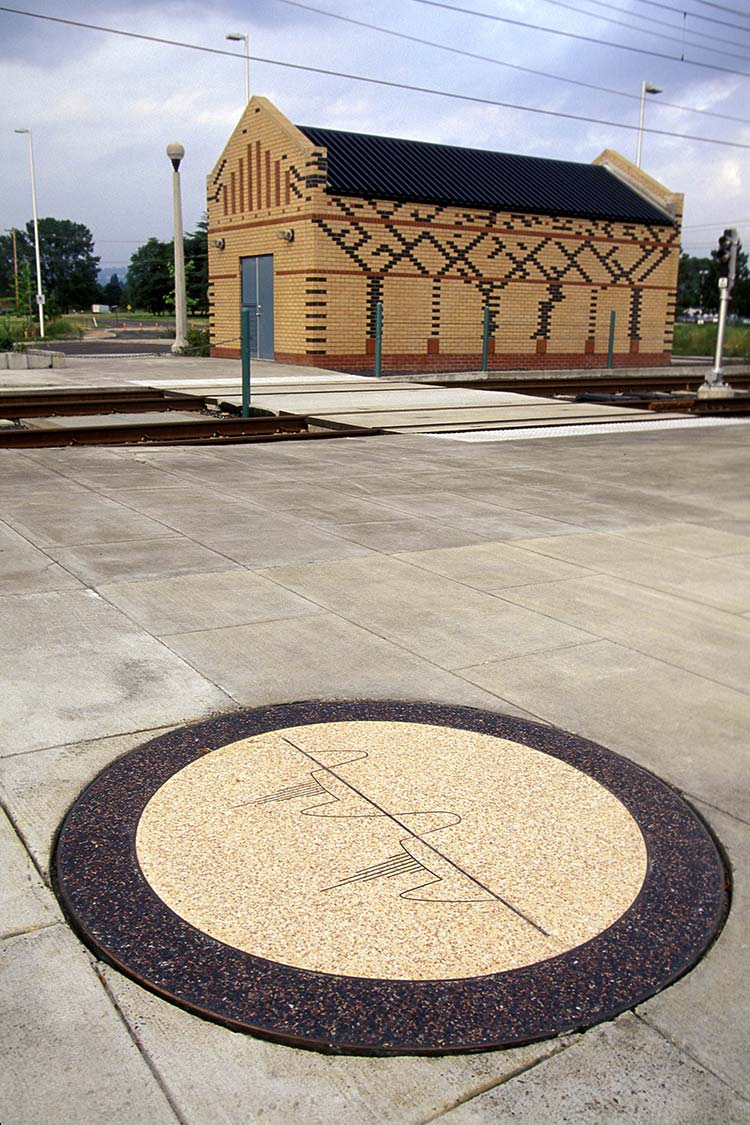 Systems building and mathematical symbol
Systems building and mathematical symbol
Beaverton Central Station
Westside design team, 1998
Westside design team artists used the phases of the moon as a symbol for change in Beaverton.
- Abstract brick patterns appear on the side of the systems building
- Four brick and quartzite “rugs” inside the shelters indicate phases of the moon
- Two moon phases rise up to become seats
- Christopher Rauschenberg’s Time Window documents the view from the shelter in 1994
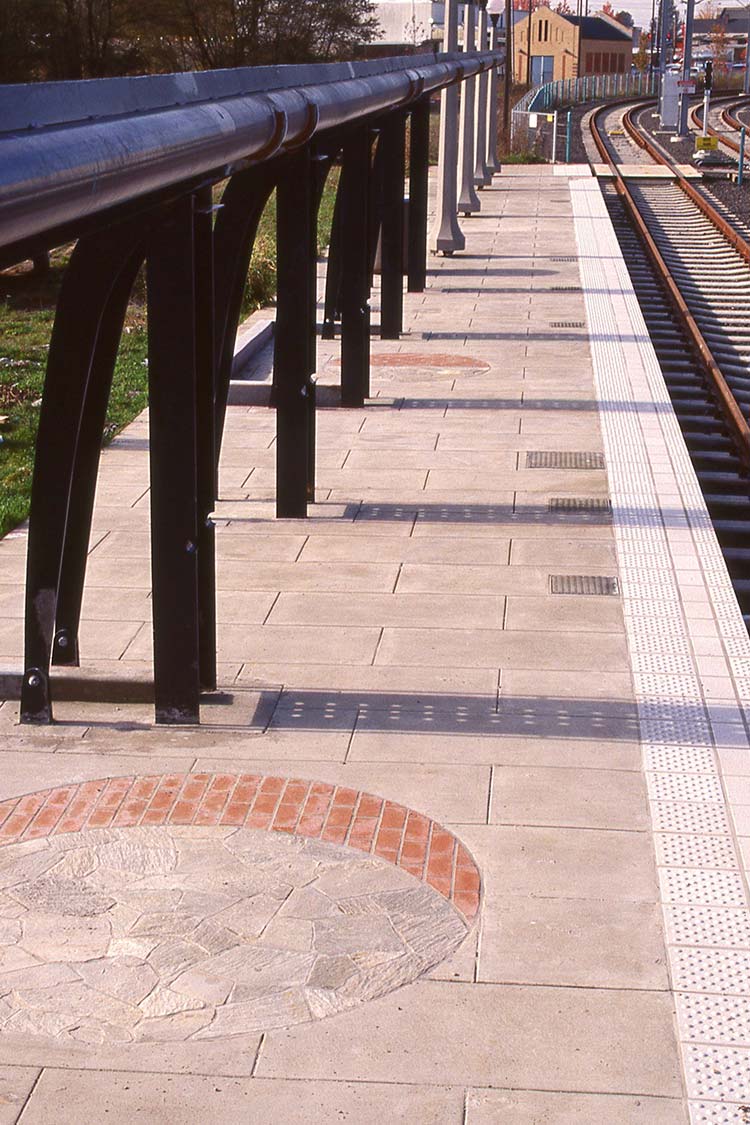 “Rugs” and systems building
“Rugs” and systems building
Lee Kelly, Icarus at Kittyhawk, 2005
Icarus at Kittyhawk, 2005, by Lee Kelly was inspired by the myth of Icarus with its timeless message about the danger of human arrogance.
The 10’ tall stainless steel sculpture with seat was purchased with funds left over from the Westside MAX project and held by METRO.
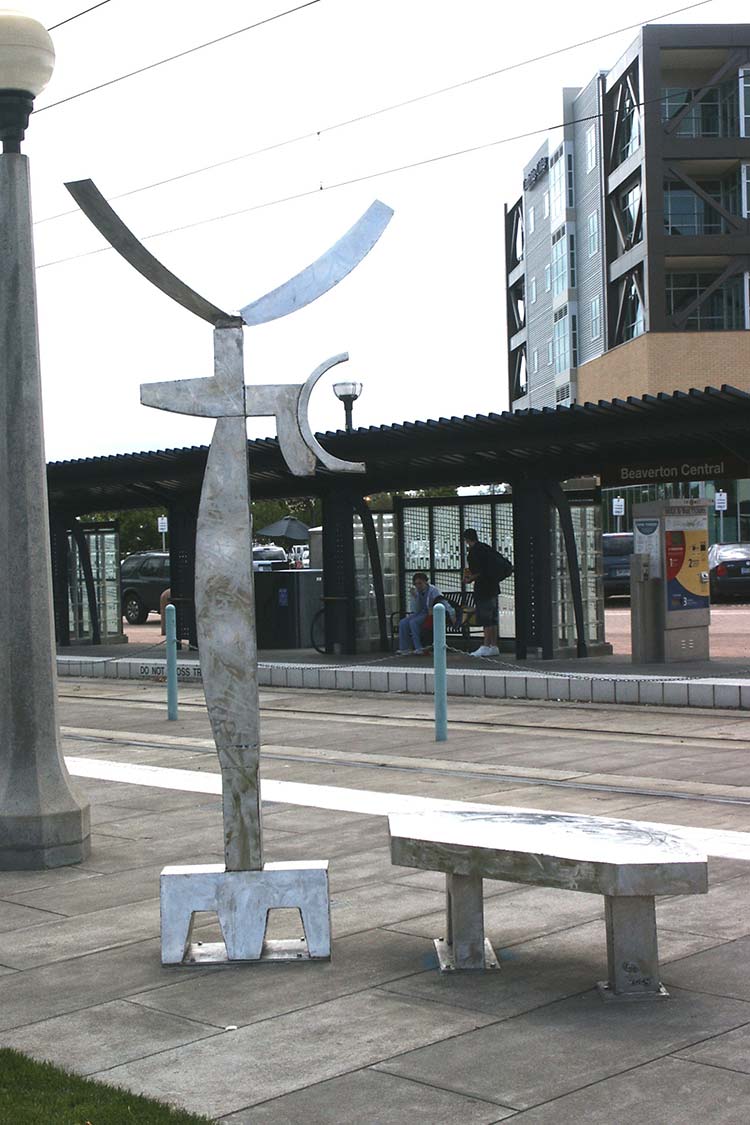 Icarus at Kittyhawk
Icarus at Kittyhawk
Beaverton Transit Center
Barbara Gilson, Katie O’Malley and Petra Prostrednik, 1998
Photographer Barbara Gilson and students Katie O’Malley and Petra Prostrednik from C.E. Mason Arts and Communications High School collaborated on a series of photos.
- Portraits of waiting passengers are humorously jumbled up on the windscreen glass
- Christopher Rauschenberg’s Time Window documents the view from the shelter in 1994
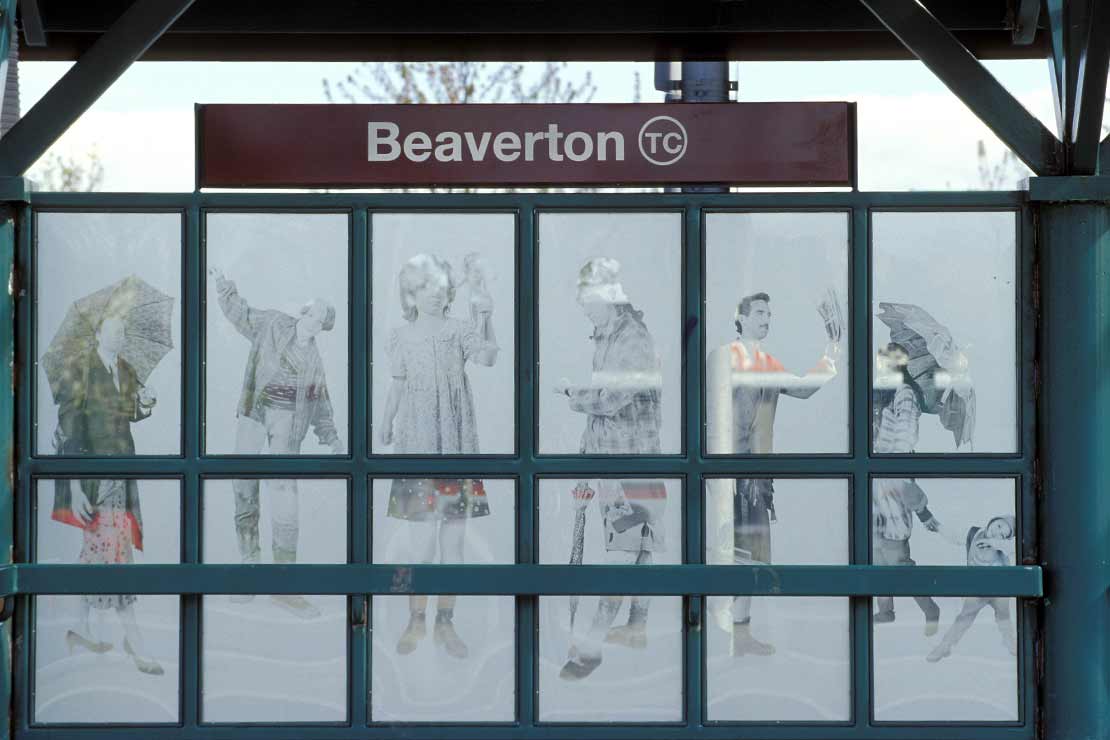 Windscreen glass
Windscreen glass
Sunset Transit Center
Westside design team, 1998
Westside design team artists collaborated with architects to recognize the area’s rural past and technological future.
- Weathered steel “ribs” in the landscape are like remnants of a bygone era
- An ornamental fence echoes the grasses around the station
- Two large, grassy mounds at the east entry were made from earth removed for the station construction
 Weathered steel and systems building
Weathered steel and systems building
Washington Park Station
Westside design team, 1998
Westside design team artists took inspiration from geology and mining at the deepest transit station in North America.
- A basalt circle the diameter of the tunnel reveals facts about mining at the entrance to the station
- The Core Sample Timeline portrays 16 million years of history with rock extracted during the design phase
- Circular stools mimic the core samples
- Light boxes at the tunnel entrances and exits feature images at the intersection of the human experience and the natural world
- Some elevator door images appear animated when the doors open
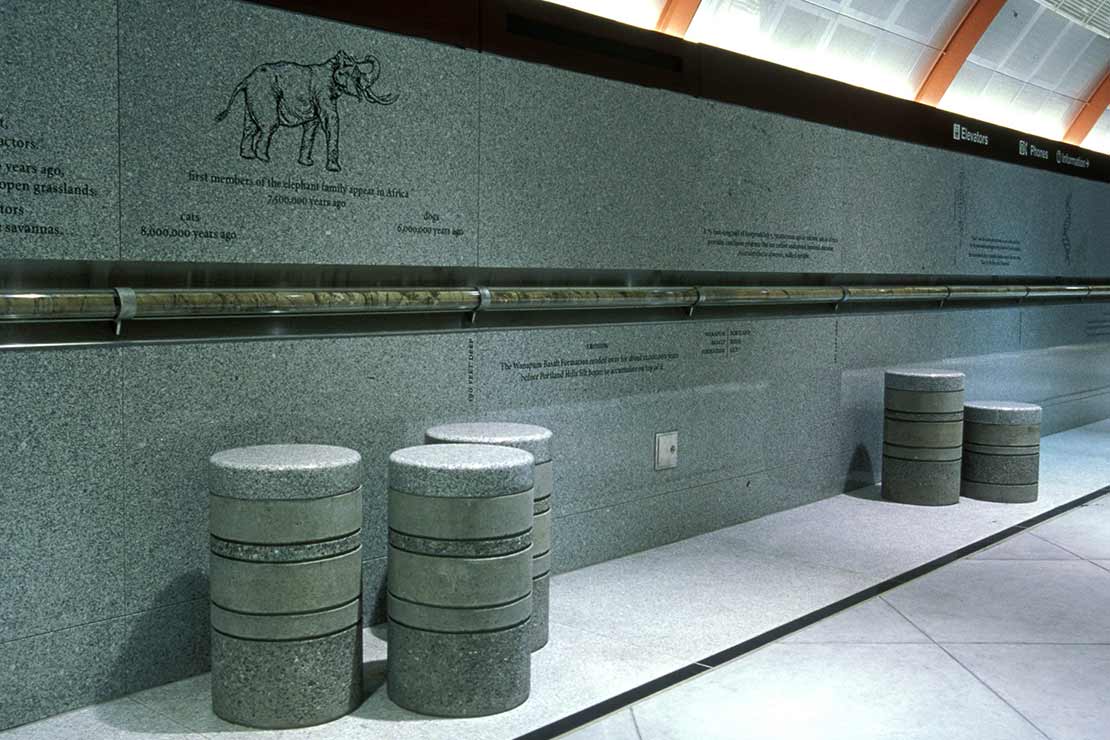 Timeline
Timeline
Goose Hollow/SW Jefferson Station
Westside design team, 1998
The Goose Hollow neighborhood is celebrated by the Westside design team artists.
- Houses and buildings rise up from tile “streets” to form seating
- Goose wings stretch across the canopy glass
- A house etched in the canopy is illuminated by the sun onto the “street” below
- A fictitious letter from a resident is etched on the shelter windscreen
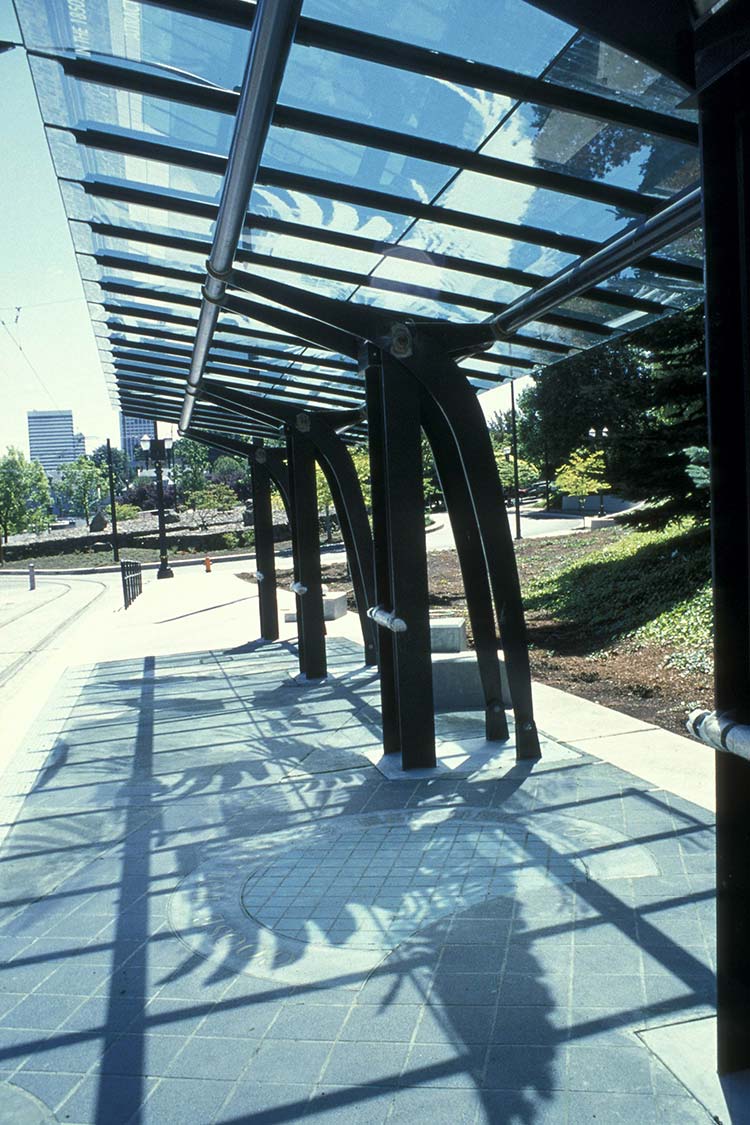 Shelter
Shelter
Kings Hill/SW Salmon Station
Westside design team, 1998
Westside design team artists acknowledged neighborhood history here and along 18th Avenue.
- Joel Weinstein’s writing about Tanner Creek is etched in granite on the platform
- Matt Wuerker drew stories and illustrations in the sidewalks along 18th
- Carolyn King and students from Lincoln High School designed the fence along Lincoln’s playing field
- A bronze goose by Rip Caswell was commissioned by the Goose Hollow Foothills League
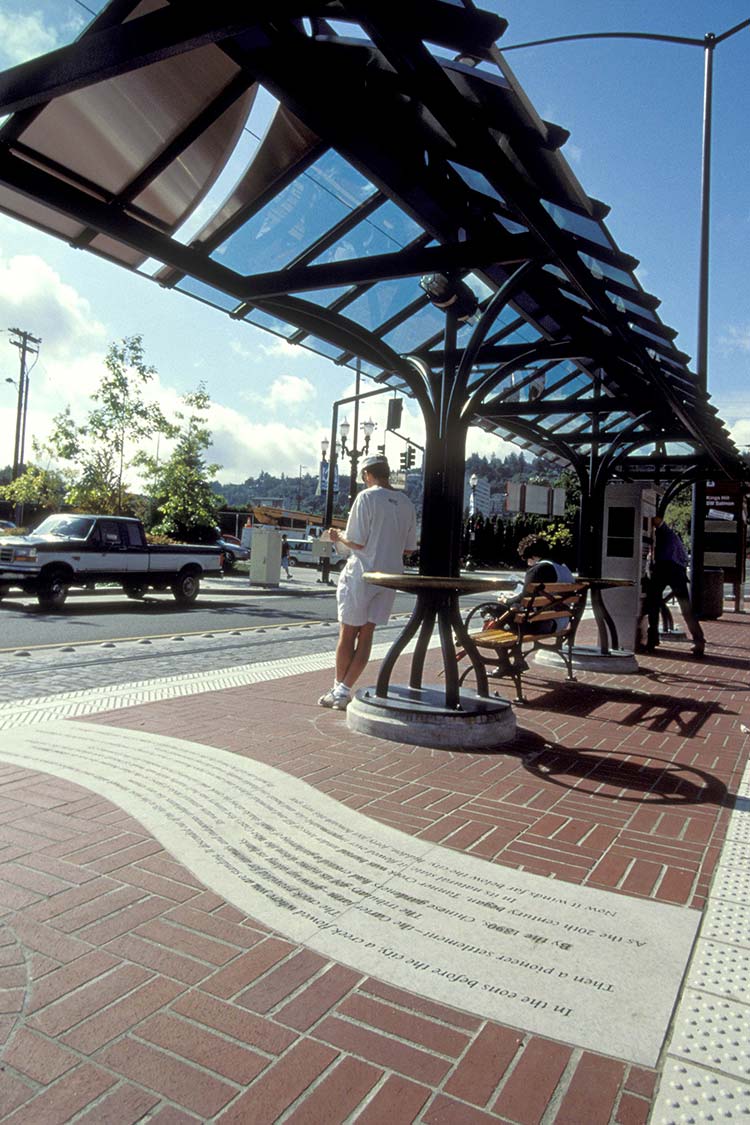 Shelter and platform
Shelter and platform
Providence Park Station
Westside design team, 1998
Westside design team artists used the buildings and plaza to express the importance of oratory to Portland’s civic history at the station then named Civic Stadium
- Robert Sullivan’s original essay on the theme is etched onto stainless steel panels covering the systems building
- Bronze podiums in the plaza invite spontaneous oratory
- Punctuation marks form seating and accents on the Yamhill platform
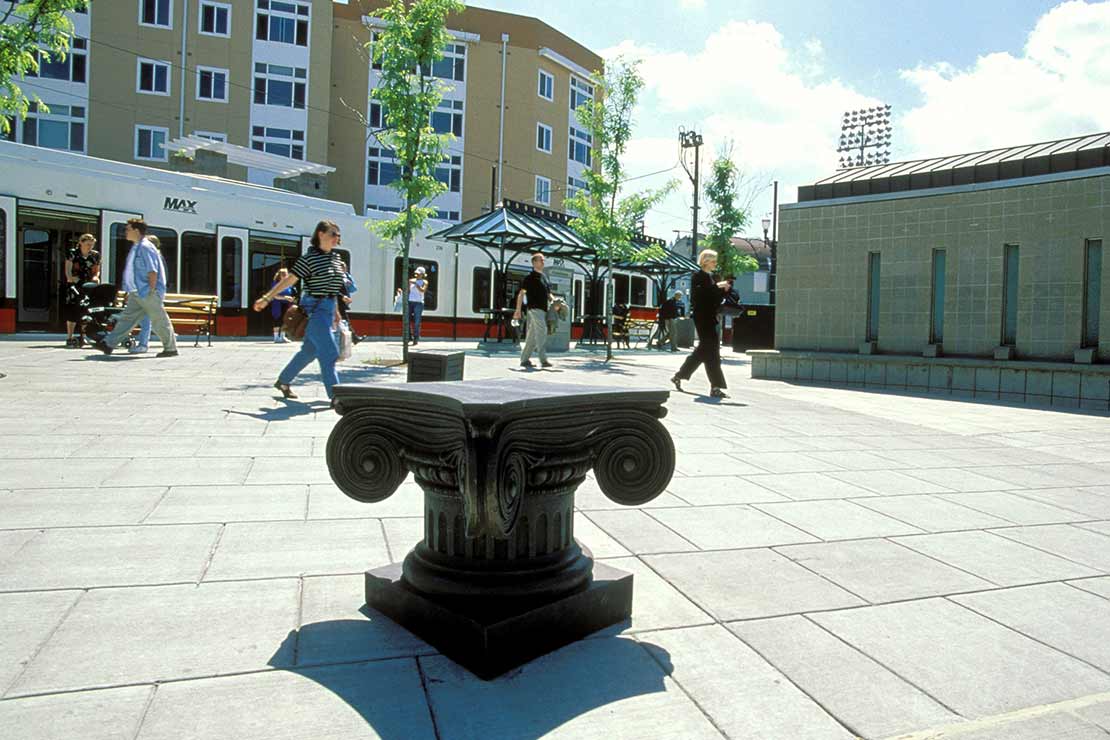 Podium
Podium
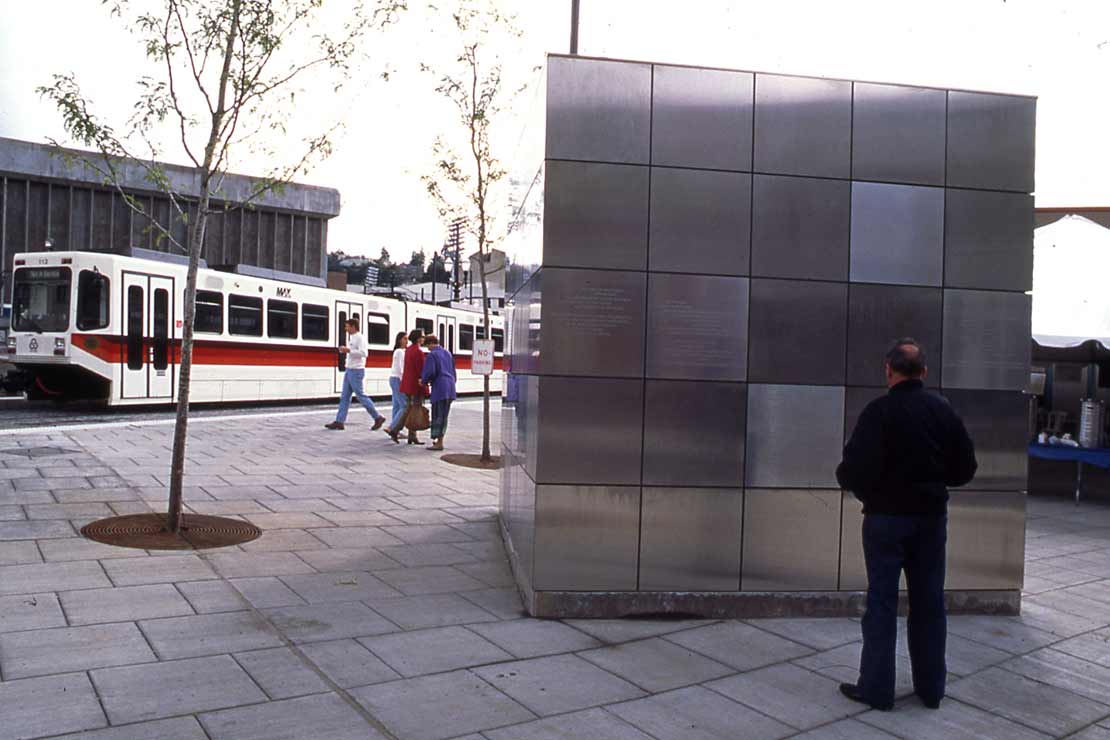 Systems building
Systems building
MAX Shelter Glass
Makelike, 2002
In 2002, the design firm Makelike created five distinct patterns to etch onto the blank, graffiti-prone panels of the Westside MAX shelter glass. They looked for common threads among the stations, and developed an appropriate pattern for each of five groupings.
- Geometric: Beaverton Central, Willow Creek, Hillsboro Central
- Hybrid: Beaverton Transit Center, Hawthorn Farm
- Tree: Beaverton Creek, Elmonica, Orenco (see above)
- Grass: Sunset Transit Center, Milikan Way, Quatama, Fair Complex, Washington St
- Grid: Merlo Rd, Tuality, Hatfield Govt. Center
 Shelter at Beaverton Transit Center
Shelter at Beaverton Transit Center

